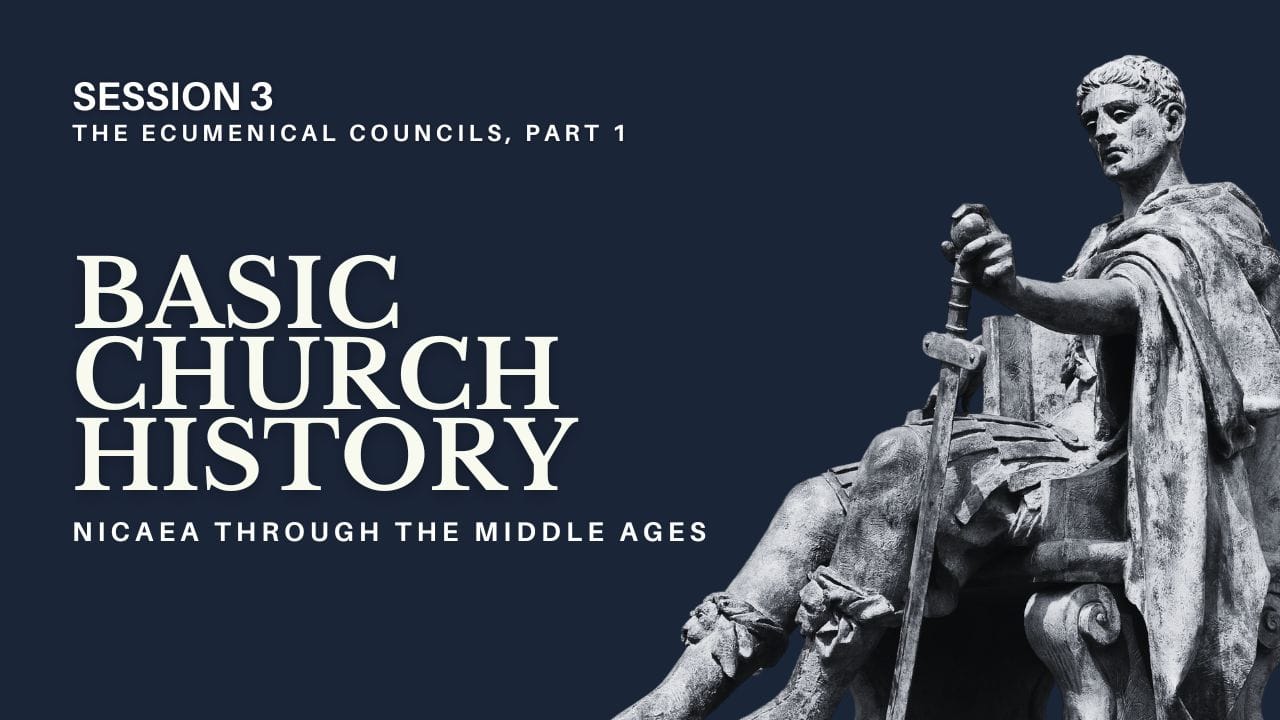Sunday School Review: Basic Church History: Nicaea through the Middle Ages, Part 3
Welcome to today’s review of the material covered in our third session: the aftermath of the Council of Nicaea and the First Council of Constantinople.

The Council of Nicaea settled some key issues, but the battle against Arianism, which denied Christ's full divinity, was far from over. The aftermath involved a time of intense theological struggle, as the early church sought to discern, define, and defend biblical truth about Christ.
If you’re new here and missed last week's review, you can find it here.
Julian the Apostate
After the reign of Constantine, who established Christianity’s privileged status within the Roman Empire, his nephew Julian (known as Julian the Apostate) attempted to reverse this trajectory. An ardent devotee of the old pagan gods, Julian sought to revive traditional Roman religion and suppress Christianity’s growing influence. His policies included rebuilding pagan temples, limiting Christian influence in education, and mocking the faith’s central doctrines. Despite his disdain for Christians, Julian begrudgingly acknowledged their remarkable compassion, generosity, and care for the marginalized, traits that had helped Christianity gain a cultural foothold throughout the empire.
In a letter to a pagan high priest, Julian lamented the contrast between Christians’ effective charity and the failures of pagan institutions. He noted how Christians cared not only for their own poor but for pagan poor as well, demonstrating a love that transcended social divisions. This witness of sacrificial generosity and communal life—rooted in Christ’s commands—had deeply resonated with the empire’s disenfranchised populations, including slaves, women, and the poor. Julian’s inability to replicate this cohesive social fabric among his pagan counterparts underscored the profound impact of Christianity on Roman society, even among those who opposed it.
Julian’s failure to restore paganism only highlighted the endurance of Christian faith and practice. His brief reign ended with his death in 363 AD, and his efforts to overturn the tide of Christian influence ultimately proved futile. This backdrop of cultural contest underscores the resilience of orthodoxy and sets the stage for the continued theological battles of the fourth century, such as the persistent threat of Arianism.
The Persistence of Arianism
The persistence of Arianism in the 4th century, despite its condemnation at the Council of Nicaea (325 AD), can be attributed to a range of factors—some theological, others political and cultural.
For one, Arianism's core teaching—that Christ was not co-eternal with the Father, but rather a created being—was, in many ways, easier for ancient people to grasp. The Arian view simplified the relationship between God the Father and Jesus Christ by subordinating the Son to the Father. This approach made sense within the prevailing Greco-Roman philosophical framework that emphasized a hierarchy of divinities and the supremacy of one almighty divinity over any subordinates.
Additionally, some professing Christians found the idea of a fully divine Christ who was also fully human too mysterious. Arianism's emphasis on a distinct, created Son appeared more logically consistent to them, avoiding what they saw as an impossibility, even absurdity: Christ being both fully God and fully man together in the one person.
Moreover, various strands of thought within the early church already leaned toward something called "subordinationism"—the belief that the Son is inferior to the Father, though still divine—before Arius formally proposed his ideas. Influential and favored figures such as Origen previously used language that many interpreted favorably toward Arianism (though Origen did not deny Christ's full divinity as Arius later would). This history and intellectual climate allowed Arius's ideas to gain a foothold. After all, they seemed conservative, not revolutionary—a logical continuation of existing theological traditions.
Finally, Arianism's success was also due to Roman political dynamics. While Emperor Constantine initially supported the Nicene decision, he vacillated on the subject of Arianism, influenced by political advisers and influential bishops sympathetic to Arius's teachings. His son, Emperor Constantius II, was openly Arian and used his political power to promote Arian bishops. This support led to the deposition and exile of Athanasius and other defenders of Nicene orthodoxy.
For many church leaders, aligning with the Arianism became politically advantageous. Holding to Arianism could mean staying in the emperor's good favor, which could bring practical benefits like securing ecclesiastical appointments and avoiding exile.
"Athanasius Against the World"
For all these reasons and more, the aftermath of the Council of Nicaea saw a fierce and prolonged struggle between orthodox Christians and Arian sympathizers. Few examples of this loom larger than Athanasius, who eventually became the bishop of Alexandria. He stood virtually alone at times in his opposition to Arianism. He argued passionately and persuasively that if Christ were not fully God, the entire foundation of Christian salvation was at risk. Without Christ's full deity, how could His death bring about reconciliation between sinful humanity and a holy God (cf. Isaiah 9:6; 53:5,11; Deuteronomy 4:24; Nahum 1:6; Psalm 130:3; John 3:16; 2 Corinthians 5:21; Hebrews 2:14-18)?
We cannot overstate Athanasius's influence. His unwavering commitment to the biblical truth that Jesus is fully God and fully man earned him the title "Athanasius contra mundum"—Athanasius against the world. Despite being exiled five times, Athanasius never backed down. His faithfulness reminds us that standing for truth often comes at a cost, but it's a cost worth paying.
The Great Cappadocians
While Athanasius battled in the West, another group of theologians emerged in the East—the Great Cappadocians. These three men—Basil the Great, Gregory of Nazianzus, and Gregory of Nyssa—were instrumental in defending orthodoxy and solidifying the church's biblical understanding of the Holy Spirit.
One of the original Nicene Creed's deficiencies was its minimal reference to the Holy Spirit. It simply affirmed belief in the Spirit, without offering further explanation. The Cappadocians took up the task of developing a robust theology of the Holy Spirit, arguing for His full divinity alongside the Father and the Son.
The First Council of Constantinople (381 AD)
Their work laid the groundwork for the First Council of Constantinople in AD 381. This council, called in part to address the deficiencies of the original Nicene Creed, produced a revised version of the creed, one that included a much fuller statement on the Holy Spirit. The council declared that the Spirit is "the Lord and giver of life, who proceeds from the Father, who with the Father and the Son is worshiped and glorified." This clarified the church's understanding of the Trinity, emphasizing that the Holy Spirit is fully divine and worthy of the same worship as the Father and the Son.
A Looming Threat
Sadly, a challenge and threat to church unity soon emerged. Churches in the West changed the creed, adding the word "Filioque," meaning "and the Son." This phrase, which asserted that the Holy Spirit proceeds from both the Father and the Son, was added to the Nicene Creed by the Western churches without the agreement of the Eastern church. Sadly, this move sparked a controversy eventually contributing to the division between the Roman Catholic Church in the West and the Eastern Orthodox Church in 1054, an event known as the Great Schism. We will discuss this tragic event in a future class.
Conclusion
For now, we note how the aftermath of the Council of Nicaea, the work of Athanasius and the Great Cappadocians, and the First Council of Constantinople all serve as powerful reminders of the church's ongoing need to defend and clarify the truth. These events shaped the future of Christianity, ensuring that the orthodox understanding of the Trinity and the nature of Christ would endure.
As we look back on this pivotal time in church history, we see God's hand at work, preserving His truth and guiding His people. The Nicene Creed, especially in its revised form, continues to unite Christians around the core truths of the faith. And the courage of figures like Athanasius inspires us to stand firm in our day, trusting that God is still at work in His church, just as He was then.
Thanks for joining us as we explore this rich history! If you found this helpful, stay tuned for more insights into the people and events that shaped the faith we confess today. May God—Father, Son, and Holy Spirit—bless and guide you as you live out these truths in your life.
Questions for Review
- Julian the Apostate acknowledged Christians’ remarkable charity and social impact, even while opposing their faith. How can the church today demonstrate a similar countercultural witness that reflects Christ’s love and care for others, especially in a secular society?
- Arianism appealed to some because it seemed to make the nature of Christ easier to understand. Why is it important for us to embrace the mystery of Christ’s full divinity and humanity, even when it challenges human logic? How does this doctrine deepen our understanding of salvation?
- Athanasius stood firm against widespread opposition, earning the title "Athanasius contra mundum" (Athanasius against the world). What lessons can we learn from his perseverance and boldness in defending biblical truth? How might this apply to challenges facing the church today?
- The Cappadocians developed a fuller theology of the Holy Spirit, emphasizing His full divinity. How does a proper understanding of the Holy Spirit shape our worship, prayer, and daily lives as Christians? What are the dangers of neglecting or misunderstanding the Spirit’s role in the Trinity?
- The controversy over the "Filioque" phrase in the Nicene Creed contributed to the Great Schism centuries later. What does this historical division teach us about the importance of unity within the church, and how can we pursue unity today while remaining faithful to sound doctrine?
Resources
Bruce L. Shelley, Church History in Plain Language (Nashville: Thomas Nelson, 1995).
Justo L. González, The Story of Christianity, Vol. 1: The Early Church to the Dawn of the Reformation (New York: HarperCollins, 1984).
B.K. Kuiper, The Church in History (Grand Rapids:L Wm. B. Eerdmans Publishing Company, 2001).
Unless otherwise indicated, all Scripture quotations are from The ESV® Bible (The Holy Bible, English Standard Version®), © 2001 by Crossway, a publishing ministry of Good News Publishers. Used by permission. All rights reserved.
